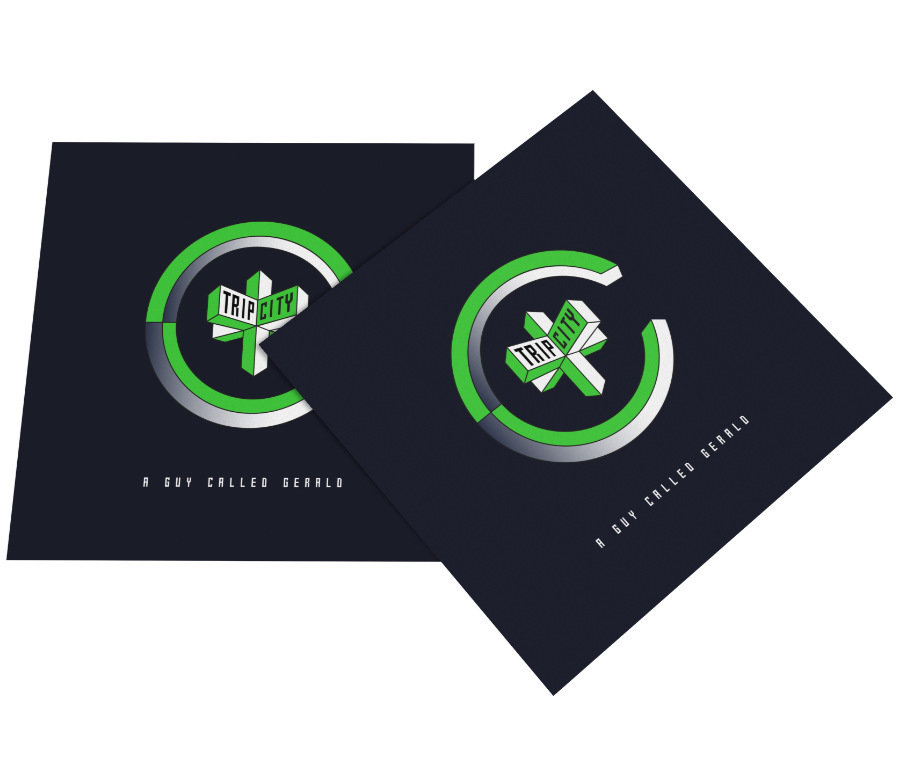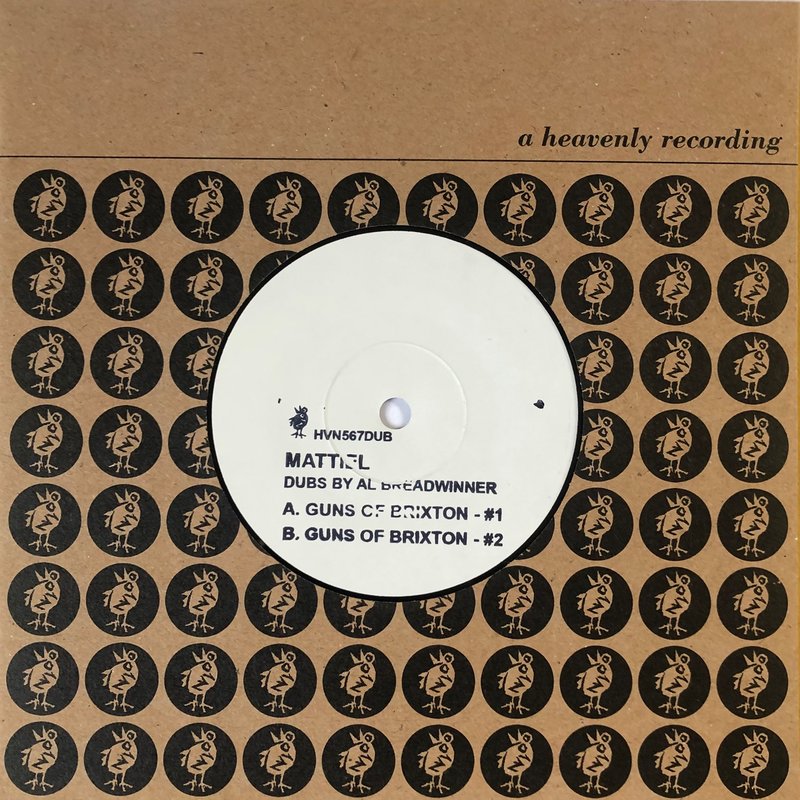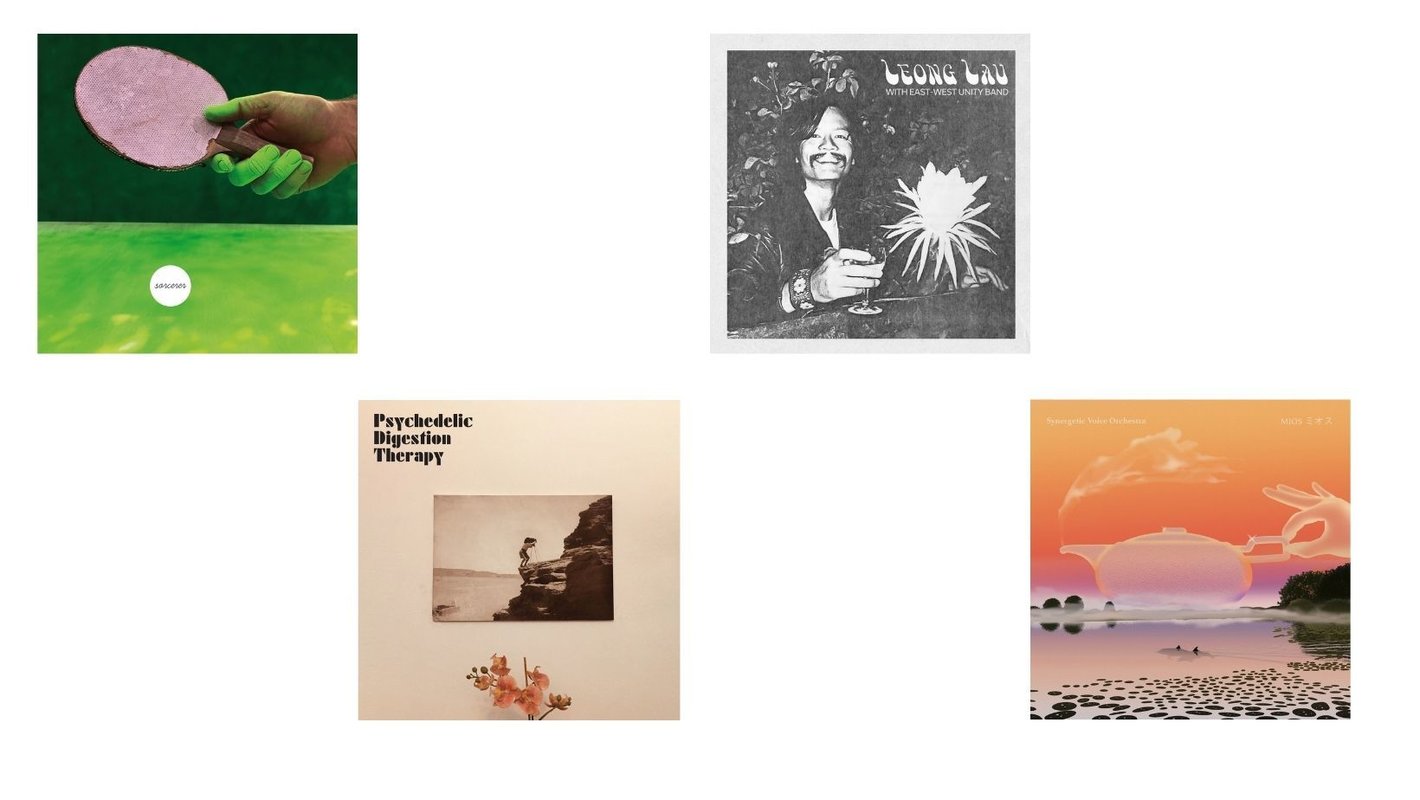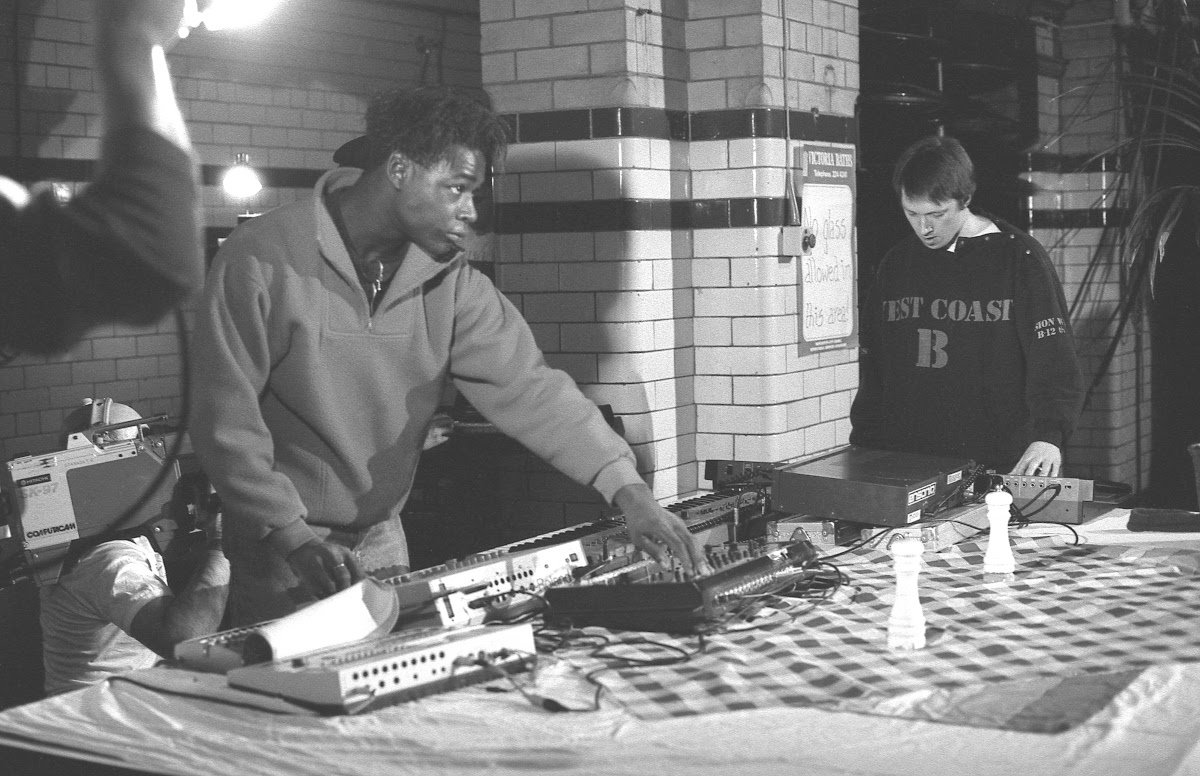
A Guy Called Gerald is an interesting guy. Considering all he’s done he’s got a great memory and recall for taking you back to times and places. This conversation took place over Zoom on 29th June and runs across his early inspiration coming from his partaking in contemporary dance classes, through to how he was making music pre-midi (it gets a bit geeky) and into falling out with 808 State and how to make a point. The reason we were chatting with Gerald is the ace Velocity Press have reissued Trevor Miller’s Trip City which originally came with a cassette that contained a soundtrack written and produced by Gerald. This was previously only available on a (rare as you like) white label and the cassette but has now been lovingly reproduced. More info in the footer. Thanks to Gerald for his time.
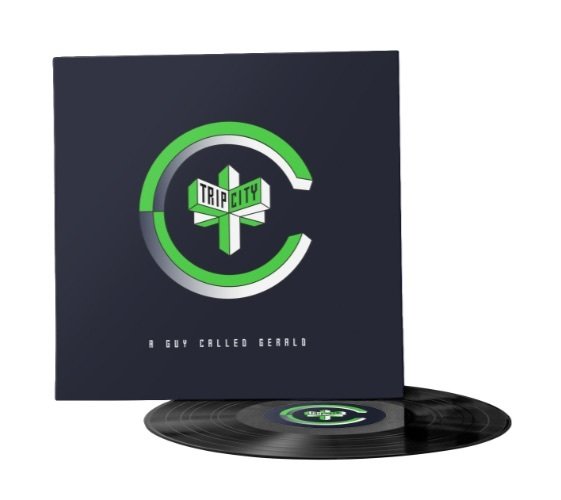
TP – I saw you studied dance when you were young which is something I never knew…
G – I started when I was really young. I was in a kids home when I was in my early teens. I was in there to make sure I attended school which I didn’t like very much. They thought, ‘well your parents aren’t forcing you to go to school so we’ll make you go here and make you go to school’. After school you had other activities - boxing, football… I saw there was one for dance and I was really into jazz fusion and I noticed that there weren’t many people doing that and this could be my secret weapon if I ever went out on the dance floor. So the interest originally was just from dancing until I got into a place where I was taking it more seriously.
When you start getting into, and learn the theories to dance, you get more and more obsessed. It was at the Manchester Dance Centre and we had two different teachers per session and the second teacher was from the Northern Ballet and she was introducing us to classical dance.
There was me and two other boys and she said there was a shortage of male dancers so she was prepping us with extra lessons. I was learning everything I could. It was my late teens… I slowly got more and more into music during this period and one thing I learnt was an understanding on what music, specifically classical music, was built from.
TP – How do you go from dance to drum machines?
G – I was always into jazz… That was my Spotify… In those days you had to go to a library and see who was playing on what records and then you’d spin off and check their records so I got more and more into that. Luckily the jazz guys named the musicians and the instruments they played so I started to see like Chick Corea playing an Arp Odyssey or Micromoog and all these synths. Then I’d go to the music shop and see these instruments and be like ‘ah thats that’.
I remember being in the basement of a music shop one day and there was this black box with coloured notes on it and I thought, ‘that looks interesting’ so I plugged it into the amp and turned it on and as soon as I heard it I knew what it was and it was an 808. It was on lots of records I liked.
The people that went to that shop were more like army jacket wearing musos so they had no interest in the drum machines. Somehow I managed to get enough pennies together to put a deposit down on it and I’m invested now so I started listening more and more to anything with a drum machine. In the shop they know I’m serious about it so by the time I left home, though I was still into dance, I was also really into making music.
TP - I guess this is around that time where you see Foot Patrol (jazz dance crew) dancing to house?
G - Foot Patrol were kid of like a crossover and then there was Broken Glass and Street Machine who were breakdance crews then there were the more like strictly jazz dancers the The Jazz Defectors who had some dealings with Tony Wilson of Factory. There was a whole range. As many genres as there were of music you had dancers and crews who were all revered in their own field. They’d go and dance for Manchester at all dayers. And that’s how I saw the world. The music was the machine that oiled that.
At that time the more rare the music the better it was in the jazz scene. Like if you saw someone with a digital mastered record from Japan, they were like £13 in ’83 or ’84, and they had the record with the strip down the side you were like ‘that’s a serious jazz person’.
You’d see other people walking around town with their record sized bag as they didn’t want you to know where they got their records. Then you had the camera bag crew and they were like the dancers. They had faded bleached jeans that were frayed at the bottom and spats and the bag with the towel and the talcum powder. This was pre acid house. Pre Hacienda. This scene was strong in Manchester and it was kind of like a melting pot as it was one of the biggest university towns.
TP – Yeah, its like my mate sent me this video of Birmingham Carnival in the 80s on the hip hop stage and they are playing an early Transmat record… It’s like when ‘Planet Rock’ came out and though it was obviously an electro record the best thing was it just sounded like the future…
G – It was a different sound and syncopation and people who were into dance would get off on that. We had Piccadilly Radio in Manchester who were really pushing that. You had Mike Shaft who would have a jazz break in the middle of the show where he would play all the latest fusion tunes. He’d only play them once but you’d record it and then you’d go out and hear it. Everyone would go nuts over these tunes and then people would get on the floor and there would be a challenge between two local crews. The energy was amazing. I never drank and managed to blag my way in and the only reason I was there was to check out the dance and the moves that were happening.
It was totally innocent times. We’d travel miles and wouldn’t even be able to afford the bus fare but you’d get in and everyone would know the tunes and be going nuts. I’d love to go somewhere now where everyone knows the tunes.
TP – I think you’re totally right… No one knows half the tunes these days…
G – It sounds like an old persons thing to say but something as simple as that… You don’t know the people, the people don’t know you, but you can look at each other and if you both know the tune and I’m going to go into the arena and dance to the guitar or keyboard solo and dance to ever nuance of that tune and you are going to see how much I know this tune. Thats how we were dancing. It wasn’t like a rave dance (plant feet and wave arms in the air) it was proper movements with the body. And thats how I got into music.
TP – You can see this is where these rhythms come from. Like I imagine when you first heard a 727 (Roland percussive drum machine with latin sounds on it) you were like ‘ahhhh I can make house with salsa here’…
G – When I first started to get into house and techno already I had a few of those instruments and if you know what’s going on and you can break it down in your own head. The last thing you want to do is copy something. You’ve got the skills and inspiration to do something new. You have the spirit of dance inside you so you want to make your own interpretation. I couldn’t figure out why someone would want to recreate something else. Like if someone did a load of steps on the dance floor and you went out and just copied them… The energy it would take to do that you might as well go on and just create your own vibe.
I get that today with people… And though I love how sample technology has progressed - we can stretch, bend, reverse - they’ll take a break and then just loop it. It’s like when people use presets on the keyboard…
The last thing you want to do is copy something. You’ve got the skills and inspiration to do something new. Like if someone did a load of steps on the dance floor and you went out and just copied them… The energy it would take to do that you might as well go on and just create your own vibe.
TP – See you say that but I was listening to a podcast with Jimmy Jam from Jam and Lewis and he was saying that all he used was presets. All the SOS Band, Janet Jackson… Presets…
G – They’re from a different school I guess. I went through an age of cutting and scratching and once you get into the grease of what’s going on in the music you want your own style. You might use the same samples and scratching but you want to do it your own way. We used to call it biting obviously when you stole someone else’s style. People would get called out for it and who wants that. We were always encouraged where I came from to do the new. We had the reggae sound system where you had your own versions you know… You can’t come with someone else’s thing. It had to be unique. Even with jungle. Like I’ll use the same breakbeats but I’ll show how I manipulate them and how I do key groupings. Especially for me. A lot of my jungle stuff was talking to other producers. ‘This is what you did with that sample, check what I did with it’. It’s all entertainment…
TP – Probably my favourite documentary is the Last Agent Of History.. It’s got you, Derrick May, Juan Atkins, George Clinton…
G – I’ve never seen it…
TP – (I describe documentary)… You don’t remember this??
G – I’ve never seen it. I can’t remember it.
TP – They are basically joining the dots about afro futurism… Goldie’s on it… Have you never seen it?
G – I probably haven’t. I’ve done a few forewords for books and stuff and I never see them. I ask to get sent a copy and never see them…
TP – That brings us to the reason we’re chatting, the reissue of ‘Trip City’ which you did the music for which they released on cassette alongside the book. That music sounds a lot like the same gear you made ‘Voodoo Ray’ on. Was it made on the same set up?
G – Yeah it was the same studio but it was a year later. Moonraker Studios. It was a commercial studio which in those days I was probably one of the only people using it in this way. If you wanted to record something professionally back then you had to go into a recording studio but there were no computers and stuff. They were set up there, pre-DAT, so they had a thing called F1 recordings which allowed you to go from analogue to digital. The only thing you had to record at home in those times was a Tascam deck to record onto cassette. Back then having a computer you could record onto would be space age. If you wanted to be serious you you’d have to go into a studio which in a way was a good filter as you had this quality control. It was on the clock so you had to make the results count.
TP – How long did Trip City take?
G – I can’t remember now. I had my own way of doing things. I had my own digital band. Like now you’d just use a computer but back then I had a couple of SH101’s, 808, 303 and all this stuff sync’d with CV in gate and like a clock…
TP – It was pre-midi?
G – Well there were two computer programmes at that time. Pro21 and maybe Cubase 1 available… There was bootlegs of that going around. I wasn’t really a computer person. All my stuff was clocked. Like my SH101’s were clocked from the 808 and I was using din sync from the 808 to sync to the 303. So it was all clocks going out on to tapes and then I’d use a clock to sync to a CAT, which was a synchronising machine, which would read SMPTE (time code) and that would then send a signal back to the 808 which was my main clock.
Later on I used Roland SPX-80 sync box that had the ability to transfer clock to midi then we could use a program called Song Pointer to sync to SMPTE so we could drop things in and out on the tape. There was loads of experimenting going on when writing tracks and I was trying to perfect my own system so I could bounce from machines to tape at the right point then I could rewind back to a certain point on a tape and drop something else in. I later bought my own two inch machine and could do this stuff myself with an MPC60 but during that period that was how we did it for ‘Trip City’.
TP – So everything was going through the desk. I mean correct me if I’m wrong but your music has never been super heavy with effects. Is this something you have always been conscious of?
G – I was basically analysing some of the early stuff I have on cassette and it would never have worked in the Hacienda as I was thinking I needed to make stuff that worked there.
TP – Yeah its infamous for the acoustics. I guess delays and stuff just didn’t work there…
G – The engineer at Moonraker he was into seeing stuff clean so he wanted a clean sound and would spend ages getting rid of tape hiss using Dolby and stuff before it went down to tape. Everything would go down pre-treated so we’d only treat stuff that was recorded. I was trying to create space between the sounds and the stereo image and some of the stuff would be lost if I caked it in reverb. I was trying to keep it really simple.
TP – One of my favourite tracks you ever made was Inertia ‘Satisfaction’… That weirdly has got lots of fx on it. What was the idea behind that project.
G – The concept was something where I had to be in disguise as someone else as technically at the time I was signed to Sony / CBS and I wanted to work on music with people from Detroit as those guys brought me up in a way. I wanted to move to Detroit at that point. ‘Inertia’ was supposed to be something different. It had to have a different sound. Not over produced but pads and also another character alongside Ricky Rouge which was more of a Chicago vibe - more acid-y. In my head I saw it that these characters would have their own sound and space.
TP – DJ Blackout - that was you?
G – No that’s someone from Detroit.
TP – Did you record more as Inertia that’s never been released? Have you got the tapes?
G – Yeah its around on DAT. I’m trying to get everything to the stage where I can create like an audio biography with the key tracks and how I went from this point to that point. There’s lots of gaps so it looks like I went from acid and house to jungle but there was all this development to get from here to there. I got a sampler and the music changed. I want to put it all into perspective.
I wanted to work on music with people from Detroit as those guys brought me up in a way. I wanted to move to Detroit at that point. ‘Inertia’ was supposed to be something different.
TP – When you are making music do you picture the scenario where this music will live or the landscape it exists in?
G – Probably less and less now but before definitely. I see myself as a drummer and there’s a dancer and you’re inspired by the dancer to make more music for them. I want to create more expression in the music for the dancer so I visualise certain things to do that. Nowadays I use environments that give more energy than the dancers. Like when I picture a dancer these days its like the dance is not as important. There’s no real dance trend or style. That is always what would introduce the movement into the music. The small jump or movement. The last thing like that would have been a fusion dance or something…
TP – I can remember doing the ‘Jingo’ (everyone lined up in lines) at the local disco and ‘Rock The Boat’ where you all sat on the floor at the local kids disco…
G – I think in general the way the internet is you don’t really have a craze anymore. it doesn’t really happen. As soon as there’s some movement it spreads globally super quickly.
TP – It doesn’t get the time to germinate.
G – Yeah exactly. It defrags. I remember jungle being on the underground stations and in pockets and it developed and germinated into the culture that had its thing and by the time it got to the world it had a special feeling to it.
TP – I fully agree. You can see that when drum and bass happened the press got interested and then left it alone and it grew and developed and to me it's like one of those scenes like heavy metal that will never die as the people that love it just love it.
G – Yeah it creates an energy. Like going down to Fabric when I used to take friends from Berlin there who had never been to a proper jungle gig and they’d be like ‘oh my god the energy in here’. Seeing it through their eyes it knocks them off their feet. It’s not just the energy its the atmosphere.
TP – I mean like it’s got such a hardcore following…
G – It’s written in stone. Like it’s never going to die. It has its own micro-system. It was never going to be played on daytime radio. It was built from these roots. It wasn’t artificial. When you grew up on urban inner city music like reggae and hip hop then jungle it all joins up.
TP – You are like a weird link in that you made ‘Blow Your House Down’ which was massive at Rage, ‘Voodoo Ray’ then the drum and bass and jungle stuff… You’re like a link between the house and bass heavy sound then the jungle…
G – There was a lot of developing. One of the first breakbeat tracks I did was called ‘Specific Hate’. Grooverider loved it. I used a breakbeat to spite the guys from 808 State as they didn’t like breakbeats.
[Ed - Gerald had some issues with not being paid for work on the hit record ‘Pacific State’ so when signed to CBS / Sony used the B side of 12 to release two tracks called ‘Specific Hate’ and ‘I Can’t Wait No More’ which are both genius but clearly making a point.]
G – When I was adding the breakbeat I realised I could do al this other stuff with it. I toyed around with it for a bit but didn’t go too far into it. I was then doing a live gig at Eclipse in Coventry and I used to do gigs with samplers… A couple of S950s and S1000 and an MPC60 and I used to go on the road with that in a rack. I was playing on the dancefloor and I remember the DJ before me was playing fast and normally I played at 125bpm. The tempo was fast though so I had to speed up what I was doing so I sped it up and I had some breaks on a floppy disc and I dropped the break under a 4/4… I tried to mix into what he was doing and then I kept all that afterwards. When I got back into the studio I started playing with that sound. It was about 1990 and I was using the MPC60 and I got more and more into it. I got more enjoyment from playing with the breaks.
TP – I suppose that tempo must have been refreshing after working at 125bpm for years. Like ‘wow 150 is fun’…
G – Yeah. Putting the breaks in and getting into key groups and working in Reason and Recycle and chopping and sampling and adding b-lines – it was just all connecting the dots.
TP – It’s just funny that the fall out with 808 State led you, although inadvertently, to the next stage… I was listening to ‘I Can’t Wait No More’ the other and I think it’s a genius way to make a point. And the fact that CBS let you put it out on a major just cracks me up…
G – (Laughs). They didn’t know what was going on. I think Martin was a bit pissed off. There was nothing they could do as it was out and done. Same thing with a lot of things in those days…
TP – Well thanks for the time.
G – Welcome.
//
'Trip City' is available now via Velocity Press. You can also support Gerald in his quest to try and scrape back some of the unpaid royalties on 'Voodoo Ray' by clicking this link.
